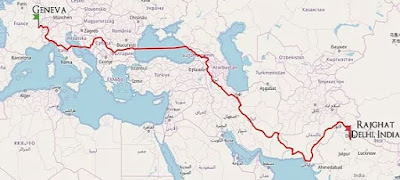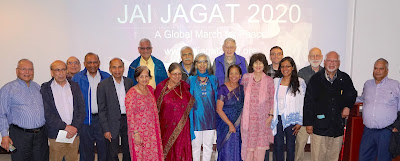Some 80 people attended the movie ‘
We’ve Concluded Our Assembly: The Saskatchewan Doukhobors’ at the historic
Mayfair Theatre on November 10, 2019, in Old Ottawa South. The 90-minute documentary was followed by a discussion led by producer-organizer
Ryan Androsoff with
Spirit Wrestler Productions.
 |
| Mayfair Theatre markee. Ryan Androsoff. |
Available for sale were DVDs of the film (90 minutes), CD recordings of the Saskatchewan Doukhobor Prayer Service (42 minutes, Russian and English); and a booklet 'Song Lyrics and Credits' (Russian, transliterated Russian, English) with a list of financial contributors and acknowledgements of participants. All can be bought online and at the
gift shop of the Saskatoon Western Development Museum and the
Doukhobor Discovery Centre in Castlegar, BC.
Donate; the Project is $20,000 short of breaking even.
In 2016, Ryan Androsoff initiated the ambitious
Saskatchewan Doukhobor Living Book Project ‘with the mission of preserving the oral history and spiritual traditions of the Saskatchewan Doukhobor community for future generations’ as a
soundscape, and to ‘start a conversation about the future of Doukhoborism for generations to come.’
This Project is specifically about ‘
Independent Doukhobors’ in Saskatchewan, who comprise about one-fourth of all Canadian Doukhobors, and are partly organized as the
Doukhobor Cultural Society of Saskatchewan (DCSS). Most descendants of
Community Doukhobors in British Columbia are not the focus.
This was my third viewing of the entire project. As soon as it was available, Ryan mailed me the DVD, CD and booklet to review.
The documentary film opens with a typical Sunday gathering (called
sobranie in Russian) of Independent Doukhobors in Saskatchewan. A traditional prayer service was performed by 8 men and 20 women (
28 singers) who recited and sung Doukhobor psalms in Russian (translations provided).
The location was the
Blaine Lake Doukhobor Community Home (which in my opinion is erroneously called the
Doukhobor Prayer Home) located 80 km (50 miles) north of Saskatoon, Saskatchewan. Blaine Lake is one of the
5 remaining active Independent Doukhobor meeting halls in Saskatchewan.
Inter-weaved throughout the 90 minutes were interviews of
30 men and women from ages 8 to 95, historic images, maps, and video clips of Doukhobor events in Saskatchewan (like the annual
Doukhobor Peace Day under a tent with community picnic outdoors).
A total of
42 participated, 12 members of the choir were not interviewed. About a third are closely related family.
William Kanigan spoke with pride about one of his two sons who turned down a lucrative military contract because it would have contradicted with his heritage roots.
I enjoyed the freshness of Jonathan Kalmakoff's daughters, Katie and Emily, who told stories learned from their father, a Doukhobor genealogist and historian. Hundreds of articles, charts and maps are on his
Doukhobor Genealogy Website.
The documentary ended at the
sobranie with the hymn (in Russian and English): 'We've Concluded Our Assembly'.
Credits followed.
Themes covered:
After the film, questions were asked about the
Doukhobor migration to Canada beginning in 1899, if there was a Doukhobor meeting in Ottawa [No], about singing, and the
transliteration of Russian to English.
At the end of the Question period, I thanked the producer and made the following comments:
This is a beautiful contribution to the cultural treasure of Doukhobors in Saskatchewan. The film will be remembered by children and grandchildren for years to come. They will recall that their ancestors believed in the Spirit of God within each person (based on a deep philosophy of love, truth, hospitality, and humanity), that peace is the way to a sustained future on Planet Earth. Nonviolence or nonkilling is central. Also they will remember that the collective style of life gave their ancestors strength to survive. And this attitude will likely prevail and give the new generation strength to carry on their mission into the future.
Ryan Androsoff and his team are to be greatly applauded for their efforts in creating this documentary film. Fundraising was a big challenge met by Doukhobors and others. The team interviewed 30 people who said many good things. The inclusion of several young people in the interviews is an acknowledgement that the new generation expects a voice with new changes. And the intent of the film was correct — ‘to help start a conversation about the future of Doukhoborism for generations to come.'
Topics not covered about the Doukhobor Movement in Saskatchewan
- The real contribution of Doukhobor settlers to Saskatchewan and Canada. See my book: Spirit Wrestlers: Doukhobor Pioneers' Strategies for Living, 2002; and search for major sources on Doukhobor pioneers in the Public Archives of Saskatchewan found on the campus of the University of Saskatchewan. Also check for ‘Saskatchewan’ articles on the Doukhobor Genealogy Website.
- The marvelous Doukhobor bread-baking project at the Saskatoon Exhibition annually since 1955. This is a national and international door-opener on the Doukhobors.
- The inspiring peace manifestations organized by Doukhobors, like attorney Peter G. Makaroff in the 1960s, and others — an inspiration for future generations in helping save our civilization from destruction.
- The unique contributions of Saskatchewan Doukhobor journals of The Inquirer, The Dove, and The Doukhobor Sheaf to alternative media.
- Classes on Doukhobor history and culture are currently taught at the University of Saskatchewan in Saskatoon by Dr. Veronika Makarova. Also Dr. Ashleigh Androsoff teaches history courses which includes Doukhobor pioneers.
Background
In 2016, I helped Ryan promote this project on Ottawa radio (
Independent Doukhobor Project on Radio, July 20, 2016), and continued to help announce the project four more times on my website (
1 Aug. 2016, 28 Oct. 2017, 20 May 2019, 27June 2019).
For over two years money was raised (
crowdfunding, donors), the choir rehearsed, film and audio crews hired, and hours spent recording the meeting service, psalm singing, and interviews with many people, including me. Today, the project is about
$20,000 short of covering all costs.
Dr. Ashleigh Androsoff helped with research, scripts and interviews. She is a history professor at the University of Saskatchewan, and Ryan’s 3rd cousin. See her 2011 doctoral dissertation: '
Spirit Wrestling: Identity Conflict and the Canadian “Doukhobor Problem,” 1899-1999'.
The project has cost about $57,000 to produce, of which $27,000 has been paid by grants and donors around the world.
$20,000 remains to be paid. Please donate.
Ryan has promoted the project on TV, radio and newspapers, all documented on his website
doukhoborlivingbook.ca and
Facebook.
Over 200 people attended the
project launch on June 28, 2019, at the Western Development Museum (WDM) in Saskatoon, with a dazzling walk-through multimedia
soundscape and
exhibit that continued through October 20, 2019. The WDM has featured
local Doukhobor history in the past, but this was the largest exhibit.
On June 29, 2019, the film was shown at the Broadway Theatre in Saskatoon, followed by a discussion.
DVD, CD and booklet available online from the
gift shop of the Saskatoon Western Development Museum and the
Doukhobor Discovery Centre in Castlegar, BC.
More
- Saskatchewan Doukhobor Living Book Project (main website)
- List of participants — choir singers, people interviewed
- Spirit Wrestler Soundscape Choir Positions (diagram, photo)
- Credits: Lists of Project Participants, Partners, Production Crew, Donors. — Need $20,000 more to cover all costs.
- Video Tour of the Spirit Wrestler Soundscape (2:14 min.) by Ryan Androsoff, Spirit Wrestler Productions, September 1, 2019.
- Museum opens exhibit looking at Doukhobor history in Saskatchewan (video 1:45 min.) by Kyle Benning, Global News, July 4, 2019.
- Still time to get your own copy of our documentary film before the holidays!, by Ryan Androsoff
- Saskatchewan Doukhobor Youth Festivals, 1955-1968, by Koozma J Tarasoff, Mich Ozeroff, Elmer Verigin and Andrei Conovaloff. 5 April 2016. — Summary of history, communities, choirs, singers, recorded songs and photos.
- New Doukhobor Song Book, with CDs. Blog, May 28, 2013. — A critique of Traditional Selections compiled by The Calgary Doukhobor Cultural Society with 32 songs and two CDs, 2013. — This critique extends to this project booklet 'Song Lyrics and Credits'. I am embarrassed because this project was so well funded, produced and promoted; and now the public and scholars can see how uneducated the Doukhobors are regarding transliteration (Romanization) of Russian words into English. When I discussed this issue with Ryan, he defended the booklet showing actual transliterations used by SK Doukhobors, which he claims is adequately explained in the booklet introduction. ('All text is derived from the Cyrillic, phonetic transliteration, and translated versions commonly found in Saskatchewan Doukhobor songbooks.') I wish I was asked to proofread the booklet before publication, and have been allowed to contribute a standard transliteration.



















